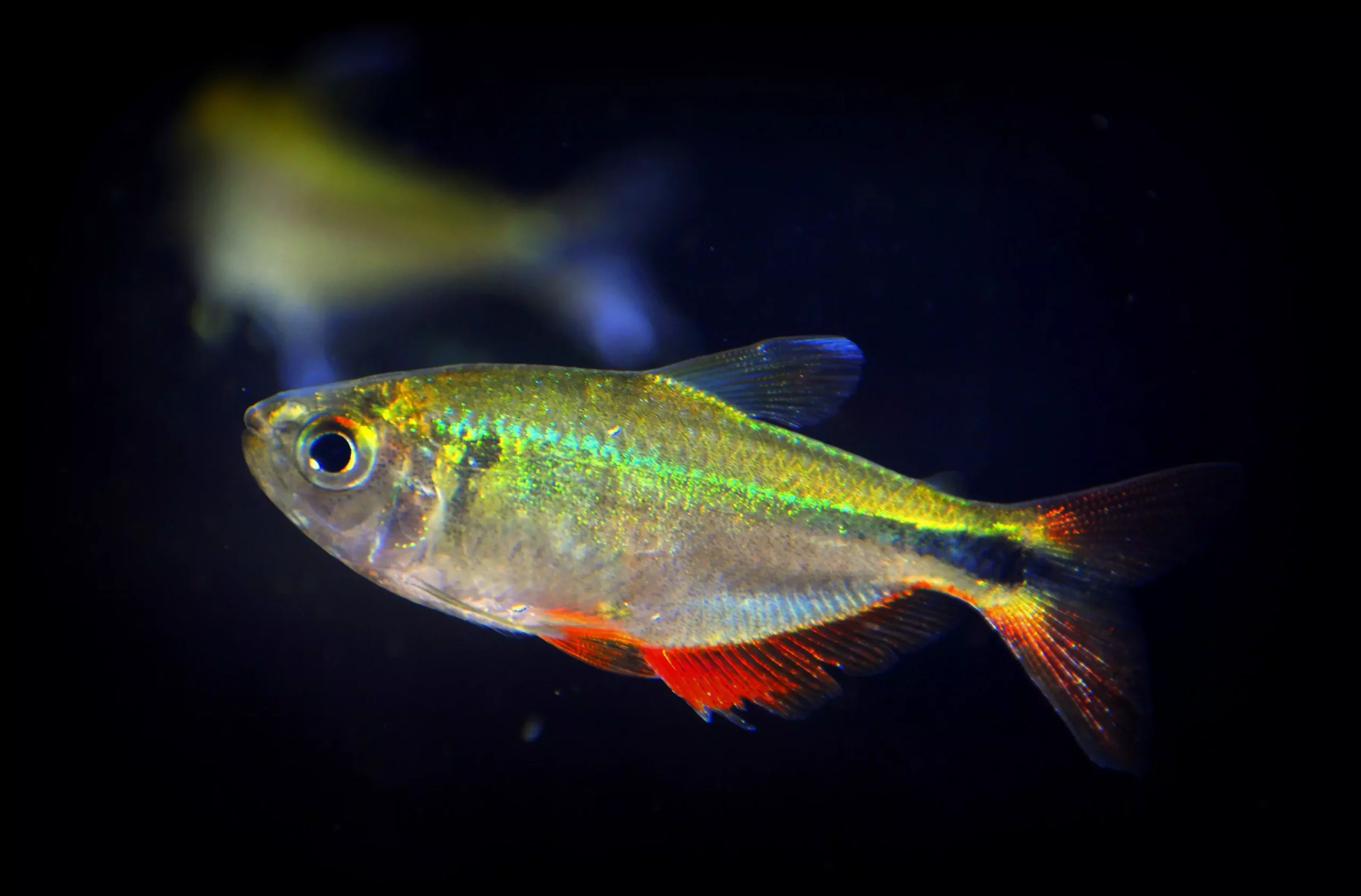The Buenos Aires tetra (Hyphessobrycon anisitsi) has earned a well-deserved reputation among aquarists for its resilience and simplistic care requirements. These vibrant freshwater fish, often referred to as diamond spot characins or red cross fish, originate from the waters surrounding Buenos Aires, Argentina. Despite once being extensively sold in the aquarium trade, their decreasing popularity can be attributed to their notorious tendency to devour aquatic plants, making them a less desirable choice for planted tanks. Today, most of the Buenos Aires tetras available in the hobby are commercially bred in fish farms situated in Florida, USA.
Adult Buenos Aires tetras generally reach a size of up to 2.75 inches (7 centimeters). Their striking silvery body is marked by a faint blue stripe starting from their gills to the tail, culminating in a distinctive black diamond-shaped spot. The fish’s fins display an alluring orange-red hue, complemented by a vivid splash of red near their eyes. Various selectively bred color mutations exist, including options with yellow tails and albino variants, appealing to aquarists seeking diversity in their tanks.
In terms of behavioral traits, Buenos Aires tetras are social organisms that thrive in schools. These same traits, however, necessitate careful consideration when selecting tank mates. While generally peaceful, they may exhibit aggression towards smaller fish or those with long fins, such as the betta or angelfish. Thus, it’s advisable to keep them with similarly sized species, including larger tetras, barbs, and danios. Interestingly, these tetras serve as excellent dither fish for non-aggressive cichlids, encouraging shy species to venture from their hiding spots.
A critical consideration when maintaining a school of Buenos Aires tetras is the type of aquarium environment offered to them. Being active swimmers, these fish require ample swimming space, favoring longer tanks over shorter, cramped ones. They adapt well to an array of water conditions, with acceptable temperature ranges from mid-60s to 80 degrees Fahrenheit, catering to both heated and non-heated setups.
However, potential owners must be cautious with live plants, as these tetras have a notorious appetite for vegetation. It is recommended to either utilize sturdy plants like Anubias and Java fern or to opt for artificial plants to ensure lush tank decor without sacrificing the tetras’ health. Ornamental driftwood and rock formations can elevate the tank’s aesthetic, providing hiding places to promote comfort and reduce stress.
An essential aspect of caring for Buenos Aires tetras is maintaining water quality. They are particularly sensitive to high nitrates and phosphates, which can accumulate over time. Regular water changes of 25-50% every two weeks, especially in densely populated tanks, are crucial to sustaining a healthy environment.
Feeding these omnivorous fish is relatively straightforward, as they relish a diverse diet. Aquarists should offer food multiple times daily, ensuring that only a small amount is provided per feeding to avoid waste. Their natural diet involves worms, crustaceans, and various plant materials. Accordingly, a mix of high-quality flake, freeze-dried, and live foods—such as bloodworms or brine shrimp—will help maintain their colorful appearance and overall health. Including greens like lettuce or spirulina flakes as part of their diet can also enhance dietary variety.
Breeding these tetras presents a rewarding challenge for hobbyists. They are egg scatterers that can be bred in pairs or groups; the latter is often more successful with a balanced male-to-female ratio. Conditioning pairs with live foods in preparation for spawning can optimize breeding outcomes. The ideal water conditions for successful spawning involve a slightly acidic to neutral pH of 6.5 to 7.2, alongside a temperature of around 75 degrees Fahrenheit.
Upon spawning, females can lay up to 2,000 eggs, and care must be taken to remove adults promptly to prevent them from consuming the eggs and fry—Buenos Aires tetras do not exhibit parental care. After approximately 24 hours, the eggs hatch, and within a few days, the fry will require nourishing diets consisting of infusoria or specially formulated fry foods until they achieve a size compatible with larger options.
The Buenos Aires tetra is an excellent choice for both novice and experienced aquarists due to its hardiness, sociability, and adaptability. While their tendency to munch on live plants may limit their compatibility with heavily planted tanks, their vibrant colors and engaging behavior make them a visually attractive addition to a community aquarium setup. Their manageable care requirements and breeding potential further solidify the Buenos Aires tetra’s position as a staple in freshwater aquarium collections.

